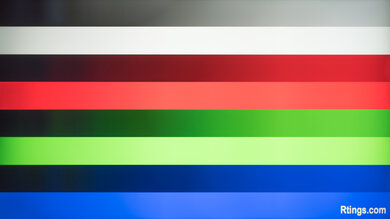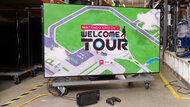The LG NANO80 2020 is a lower-midrange 4k TV with okay overall performance. It's a larger variant of the LG NANO81 and offers similar performance and features, except there isn't any local dimming. It has an IPS panel with fairly wide viewing angles, but that comes at the cost of its low contrast ratio, and blacks appear gray when viewed in the dark. Despite missing many gaming features, it has a decent response time and incredibly low input lag, so it's a good choice for casual gaming. Unfortunately, HDR content doesn't pop how it should because it doesn't get bright in that mode, but it displays a wide color gamut for HDR content. Lastly, LG's WebOS is easy-to-use and the LG Content Store has a great selection of apps available to download.
Our Verdict
The LG 75NANO80UNA is an okay TV for most uses. It's decent for watching TV shows or sports and performs best in wide seating arrangements due to its wide viewing angles. It's good for gaming thanks to its incredibly low input lag and decent response time. However, it's not a good choice for watching movies in dark rooms because it has a low contrast ratio and there's no local dimming feature.
- Fairly wide viewing angles.
- Decent reflection handling.
- Incredibly low input lag.
- Low contrast ratio.
- No local dimming feature.
- Poor HDR peak brightness.
The LG 75NANO80UNA is disappointing for watching movies. It has an IPS panel with a low contrast ratio and no local dimming feature, so blacks appear closer to gray when viewed in the dark. Fortunately, it upscales 1080p content well and removes 24p judder from Blu-rays.
- Removes judder from native 24p sources.
- Low contrast ratio.
- No local dimming feature.
The LG 75NANO80UNA is decent for watching TV shows. It has fairly wide viewing angles and the image remains accurate even if you walk around while watching. It also upscales lower-resolution content without any issues. Sadly, it doesn't get very bright and has only decent reflection handling, so it's best to avoid using it in well-lit rooms.
- Fairly wide viewing angles.
- Decent reflection handling.
- Doesn't get bright enough to combat glare.
The LG 75NANO80UNA is decent for watching sports. It has a decent response time that results in minimal motion blur, but you may notice image duplication due to the backlight's flicker. It has wide viewing angles if you want to watch the game in a wide seating arrangement. Unfortunately, it's best to avoid using it in a bright room as it has a disappointing peak brightness and only decent reflection handling.
- Fairly wide viewing angles.
- Decent reflection handling.
- Decent response time.
- Doesn't get bright enough to combat glare.
- Visible dirty screen effect in the center.
The LG 75NANO80UNA is good for video games. It has incredibly low input lag and a decent response time, but you may notice image duplication because of the backlight's 120Hz flicker. Unfortunately, it lacks many features like variable refresh rate support or a Black Frame Insertion feature.
- Decent response time.
- Incredibly low input lag.
- Low contrast ratio.
The LG 75NANO80UNA is disappointing for watching HDR movies. It displays a wide color gamut for HDR content and has decent gradient handling, but it doesn't get bright enough to make highlights pop. Also, it has a low contrast ratio and there's no local dimming, so it doesn't perform well in dark rooms.
- Displays wide color gamut.
- Low contrast ratio.
- No local dimming feature.
- Poor HDR peak brightness.
The LG 75NANO80UNA is okay for HDR gaming, mainly due to its good gaming performance. It has incredibly low input lag and a decent response time for a responsive gaming experience. It displays a wide color gamut for HDR content, but it has low peak brightness, no local dimming feature, and a low contrast ratio.
- Decent response time.
- Incredibly low input lag.
- Displays wide color gamut.
- Low contrast ratio.
- No local dimming feature.
- Poor HDR peak brightness.
The LG 75NANO80UNA is good to use as a PC monitor. It has fairly wide viewing angles, so the image remains accurate if you sit close. It has incredibly low input lag and displays chroma 4:4:4, which is important for reading text. Unfortunately, even though it has decent reflection handling, it doesn't get bright enough to combat glare in well-lit rooms.
- Fairly wide viewing angles.
- Incredibly low input lag.
- Displays chroma 4:4:4.
- Doesn't get bright enough to combat glare.
Changelog
- Updated Nov 21, 2022: Compared the
- Updated Jul 29, 2021: Added the real content local dimming videos.
- Updated Mar 01, 2021: Converted to Test Bench 1.6.
- Updated Nov 20, 2020: Review published.
Check Price
Differences Between Sizes And Variants
We tested the 75 inch LG NANO80 2020, which is the only size available for this model in the United States and is only sold at certain retailers for Black Friday. This TV is a variant of the LG NANO81, which has a center-mounted stand and a local dimming feature. There are other sizes of the NANO80 available in Canada and Europe, which are listed below, and for the most part, we expect our results to be valid for the 49 inch, 55 inch, and 65 inch variants. The LG NANO79 is sold in Europe and seems to be a similar TV, but with a center-mounted stand as well.
| Size | US | Canada | Europe |
| 49" | - | 49NANO80UNA |
49NANO806NA |
| 55" | - | 55NANO80UNA |
55NANO806NA |
|
65" |
- | 65NANO80UNA |
65NANO806NA |
| 75" | 75NANO80UNA | 75NANO80UNA | - |
If someone comes across a different type of panel or if their TV doesn't correspond to our review, let us know and we'll update the review. Note that some tests, such as the gray uniformity, may vary between individual units.
The unit we tested was manufactured in September 2020 and you can see the label here.
Popular TV Comparisons
The LG NANO80 2020 is an okay overall TV and provides alright performance for its price and size. However, there are better options out there, especially if you don't need wide viewing angles and prefer something with better contrast, such as the Samsung TU6980. Also see our recommendations for the best TVs for Xbox Series X, the best TVs for PS5, and the best 4k TVs.
The LG NANO81 is better than the LG NANO80 2020. The NANO81 gets brighter, has much better reflection handling, and it has a local dimming feature, but it doesn't perform well. However, the NANO80 has a quicker response time and much better out-of-the-box color accuracy, but this may vary between units.
The Samsung TU8000 is better overall than the LG NANO80 2020, although they use different panel types. The Samsung has a VA panel that provides a better contrast ratio and better black uniformity. It also gets a bit brighter and has a Black Frame Insertion feature. However, the LG has an IPS panel with wider viewing angles, it has a quicker response time, and it displays a wide color gamut for HDR content, which the Samsung doesn't.
The LG NANO80 2020 and the LG NANO75 2021 are nearly identical, and most differences between them can be attributed to panel variance. The NANO75 2021 has better gradient handling, though, and it supports eARC.
The Samsung Q60T is much better than the LG NANO80 2020, although they use different panel types with different advantages. The Samsung uses a VA panel with a much better contrast ratio, gets significantly brighter, has better color accuracy, and better uniformity, but this may vary between units. The LG, however, has an IPS panel with wide viewing angles, and it also has a quicker response time for less motion blur.
Test Results

The LG 75NANO80UNA has a decent, yet simple, design. It doesn't have a premium look like other models in the NanoCell Series, such as the LG NANO81, and looks more like the LG UN7000. It has somewhat thick bezels and the stand consists of two feet instead of the center-mounted stand found on higher-end models.
The back of the TV is made of smooth metal and doesn't have any patterns etched into it. Sadly, there's no cable management.
The LG 75NANO80UNA has a decent build quality. It's mainly metal and feels fairly sturdy. However, the back where the inputs are flexes a bit, and the TV wobbles slightly, but it's not bad.
The LG 75NANO80UNA has a mediocre contrast ratio, which is expected from an IPS panel. Blacks appear closer to gray when viewed in the dark, and there's no local dimming feature to further improve the black level.
The LG 75NANO80UNA has disappointing SDR peak brightness. It maintains its brightness consistent across different content, but it doesn't get bright enough to combat glare in well-lit rooms. If you want something brighter, check out the LG UN6970.
We measured peak brightness after calibration in the 'Expert (Dark Room)' Picture Mode with Backlight at its max and Color Temperature set to 'Warm2'. If you want something brighter, then consider the LG QNED80.
Update 07/29/2021: Added the real content local dimming videos.
Even though LG advertises that the LG 75NANO80UNA has a local dimming feature, it doesn't have one. The video above is provided for reference only.
Update 07/29/2021: Added the real content local dimming videos.
The HDR peak brightness is poor. It doesn't get bright enough to make vivid colors stand out in HDR and small highlights are dim due to the TV's frame dimming.
We measured HDR peak brightness in the 'HDR Cinema' Picture Mode with Backlight and Contrast each at their max and Color Temperature set to 'Warm2'. Once again, we got the brightest image possible with these settings, as seen in the 10% window.
Our unit has okay gray uniformity, but this may vary between units. The edges of the screen are visibly darker and there's dirty screen effect in the center, which can be distracting during sports. Uniformity is much improved in near-dark scenes.
This TV's black uniformity is unremarkable, but it's better than other LG TVs we've tested, such as the LG NANO81. There's some clouding throughout and there's backlight bleed near the bottom right corner. Note that black uniformity may vary between units.
The LG 75NANO80UNA has fairly wide viewing angles, which is expected from an IPS panel. It's suitable for wide seating arrangements as the image remains accurate when viewing from the side.
The LG 75NANO80UNA has decent reflection handling. It performs well in moderately-lit rooms, but the reflections may be too distracting with direct sunlight on it.
The out-of-the-box accuracy is good, but this may vary between units. Most colors and white balance are only slightly inaccurate, and it shouldn't be too noticeable for most people. However, the color temperature is much colder than our 6500K target, and gamma seems to follow a 2.0 target instead of 2.2, so most scenes are brighter than they should be.
The color accuracy after calibration is outstanding. Any remaining inaccuracies with colors and white balance can't be spotted by the naked eye. Gamma follows the target almost perfectly, and the color temperature is much closer to the 6500K target, but it's still on the cold side.
You can see our recommended settings here.
The LG 75NANO80UNA upscales 720p content, such as from cable boxes, well and there aren't any artifacts.
The LG 75NANO80UNA displays native 4k content perfectly and there aren't any obvious issues.
Like the LG UN7300, the LG 75NANO80UNA uses an ADS (Advanced Dimension Switching) panel, which behaves like an IPS panel.
The LG 75NANO80UNA has a good wide color gamut for HDR content. It has excellent coverage of the commonly-used DCI P3 color space, but its coverage of the wider Rec. 2020 color space is limiting.
The EOTF follows the target PQ curve fairly well until it rolls off at its peak brightness. The image is similar in 'Game' mode, as you can see in this EOTF.
If you find HDR too dim and want the brightest image possible, enable Dynamic Tone Mapping, set Dynamic Contrast to 'High' with Brightness and Contrast at their max. This results in a slightly brighter image, as you can see here.
This TV has an unremarkable color volume. It's limited by its low peak brightness and low contrast ratio, and it can't display dark, saturated colors well.
The LG 75NANO80UNA has decent gradient handling. The most noticeable banding is with grays and greens, and there's some with reds and blues as well. Setting the Smooth Gradation feature to 'Medium' or 'High' doesn't affect the test pattern, but it really smooths out gradients in real content, at the cost of losing fine details. The newer LG NANO75 2021 has much better gradient handling.
Although some IPS panels can suffer from temporary image retention, this doesn't appear to be permanent as seen in our long-term test.
The LG 75NANO80UNA has a decent response time. There's some overshoot in darker transitions, so you may notice motion artifacts in dark scenes. You also may notice image duplication due to the backlight's flicker.
There's no Black Frame Insertion feature and the backlight always flickers at 120Hz.
The LG 75NANO80UNA can interpolate lower-frame rate content up to 60fps. It performs somewhat well and smooths out motion in quiet scenes, but there are more artifacts in busy scenes. You also may notice image duplication due to the TV's 120Hz flicker.
See here for the settings that control the motion interpolation feature.
Due to the slower response time, there's not much stutter with lower-frame rate content.
This TV removes judder from native 24p sources, such as native apps or Blu-ray players. For it to work, simply enable Real Cinema.
The LG 75NANO80UNA doesn't support any variable refresh rate technology.
The LG 75NANO80UNA has incredibly low input lag, whether you're gaming in 4k or 1080p, as long as you're in 'Game' mode. It also has an 'Auto Low Latency Mode' that automatically switches the TV into 'Game' mode when a game from a compatible device is launched, ensuring the lowest input lag possible. For it to work, simply enable Instant Game Response.
The LG 75NANO80UNA supports most common resolutions at 60Hz, including 1440p. It supports chroma 4:4:4 at any resolution, which is important for reading text if you're going to use it as a PC monitor. Set the icon for the input you're using to 'PC' in the Home Dashboard to display chroma 4:4:4. For full-bandwidth signals, simply enable HDMI Ultra HD Deep Color.
The LG 75NANO80UNA only supports Dolby Digital audio formats via ARC or optical but doesn't support any DTS formats. For ARC to work, set HDMI Input Audio Format to 'Bitstream' for the HDMI input you're using, Digital Sound Out to 'Pass Through', and Sound Out to HDMI ARC in the sound settings. If you want a TV with better support for audio passthrough and eARC support, check out the LG NANO75 2021 instead.
The distortion performance is okay. There's some minor distortion at moderate listening levels, and it gets more noticeable at its max volume. However, this depends on the content and not everyone may hear it.
This TV runs on WebOS, which is easy to use and fairly smooth to navigate. Unlike the LG NANO81, we didn't experience any bugs during testing.
There are ads on the Home Dashboard and in the LG Content Store, but we weren't able to take a picture of them.
The LG 75NANO80UNA comes with the same Magic Remote found with other TVs in the NanoCell Series. You can use it as a point-and-press remote, like a computer mouse, or as a traditional remote with its navigation buttons. There are quick-access buttons to popular streaming services, and the voice control allows you to change inputs, search for content, or change the TV's settings.




























































































